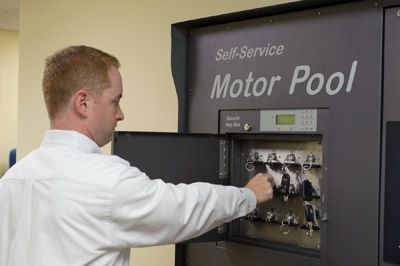
Utility Fleets and the Sharing Economy
In our increasingly shared economy, even some utility fleets are moving from “mine” to “ours.”
This certainly makes sense. In addition to the fact that utility equipment and vehicles often are costly, they’re also unlikely to be in constant use. Pooling and sharing resources, then, can help cut down on surplus, reduce expenses and streamline operations.
The even better news? As the sharing economy has matured – think of Airbnb, Uber and Lyft – so have the technology offerings that help make it possible. There’s online forum MuniRent (www.munirent.co), for example, which allows municipalities to share surplus goods and equipment. AssetWorks (www.assetworks.com) offers fleet management software along with an automated motor pool solution, and allows reservations through smartphones and tablets. And then there’s Agile FleetCommander (www.agilefleet.com), web-based fleet and motor pool software that has been used by fleets in virtually all categories.
Naturally, the argument can be – and often is – made that there’s a segment of a utility fleet that can’t be downsized because it’s used during emergencies and peak demand. It’s also true that some vehicles have specialized tools onboard that are assigned to a particular individual.
The key is in recognizing that “no vehicle sharing initiative should try to apply the same rules for all types of vehicles and equipment,” said Ed Smith, co-founder, president and CEO of Agile Access Control Inc., developer of the Agile FleetCommander software. Fleet managers must acknowledge that real obstacles are present, he said, but also that some constructed barriers to sharing “simply aren’t fact-based.” Technology can help fleet managers know who has custody of a vehicle – and its keys – as well as assist in reporting and chargebacks.
Dave Meisel, senior director of transportation and aviation services for Pacific Gas and Electric Co., said his department has tried sharing initiatives on multiple occasions, with varying levels of success. One of the challenges is that many first responders are dispatched from their homes, so their equipment is not at a central location. But there are trouble trucks, line trucks, dump trucks, digger derricks, directional boring equipment, cars and pickups that are shared across PG&E’s operating departments.
“When it’s reasonable and practical, you can have an asset in gas today and in electric tomorrow,” Meisel said. However, he doesn’t consider it a rightsizing effort as much as he does good business sense – especially when scaled to a fleet of 15,000 assets and a service territory of 75,000 square miles.
But yes, there has been pushback.
“Most of the people I know in this industry, they’re really conscious of trying to be responsive, trying to meet our customers’ needs as soon as possible,” Meisel said. “They’re great people and are really hard-wired for emergency and customer response. Sometimes that thought process leads them to want to keep equipment locally just in case something bad happens. But when you add that up over 100 locations, that can add up to a lot of equipment and a significant, unnecessary operating expense.”
Being able to make the case for the business decision has helped many come around, Meisel said, and if the needed equipment isn’t available through the pool, a rental follows.
Florida Power & Light Co. also has a pool of utility vehicles, the result of a utilization analysis several years ago. The organization, an Agile Access Control customer that uses the Agile FleetCommander software, was able reduce its fleet by more than 60 specialty vehicles, Smith said, while still providing a high level of service. “Not only did they receive $7.5 million when they disposed of the vehicles, they no longer had the costs associated with depreciation, replacement and maintenance,” he said.
So, where does a fleet manager even start? Meisel said it begins with a true understanding of how equipment is currently being used – and how it’s not.
Ultimately, though, the success of any effort may come down to the way it’s presented. Cost savings can lead to the purchase of newer equipment and a younger fleet overall. In addition, the ability to turn over reporting, cleaning and fueling to a central facility might help make sharing a winning proposition for all involved.
About the Author: Fiona Soltes is a longtime freelance writer based just outside Nashville, Tenn. Her regular clients represent a variety of sectors, including fleet, engineering, technology, logistics, business services, disaster preparedness and material handling. Prior to her freelance career, Soltes spent seven years as a staff writer for The Tennessean, a daily newspaper serving Nashville and the surrounding area.
*****
The Sharing Economy by the Numbers
Today’s sharing economy – also known as the on-demand economy, peer-to-peer economy or collaborative consumption – has stretched across numerous industries. Airbnb, Spotify, TaskRabbit, Uber and others all offer opportunities to share and share alike.
But how much is it catching on? In April 2015, PwC (www.pwc.com) released the following statistics in “Consumer Intelligence Series: The Sharing Economy.” At that time:
• 19 percent of adults surveyed had engaged in a sharing economy transaction; 7 percent had been providers.
• 86 percent agreed that sharing is making life more affordable.
• 83 percent agreed the sharing economy results in greater convenience and efficiency.
• 76 percent believed the sharing economy is better for the environment.
• 72 percent of adults were concerned that the quality of sharing economy experiences will be inconsistent.
• 89 percent believed the sharing economy is based on trust between provider and user, but 69 percent were concerned about putting their trust in these services.
To see the full report, visit www.pwc.com/us/en/industry/entertainment-media/publications/consumer-intelligence-series/assets/pwc-cis-sharing-economy.pdf.


